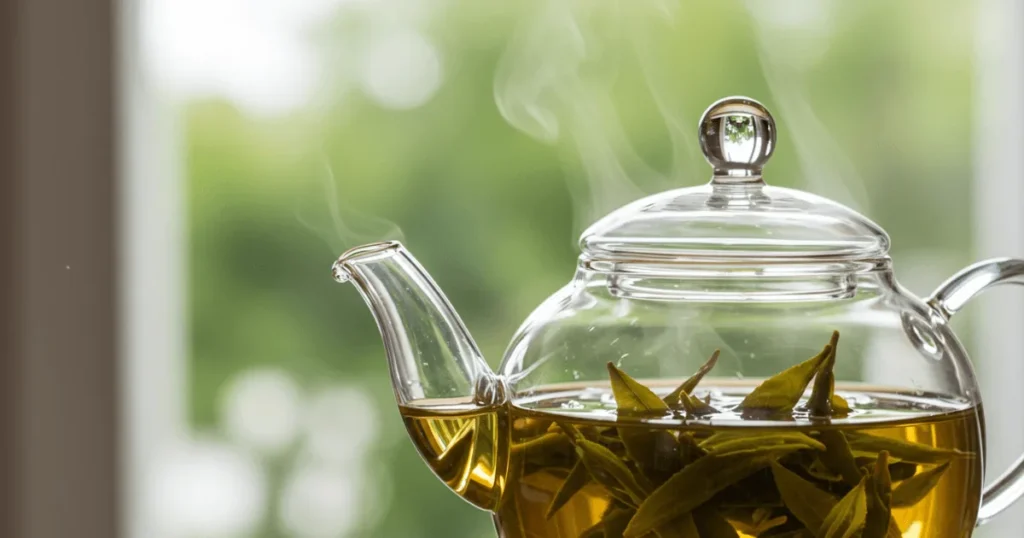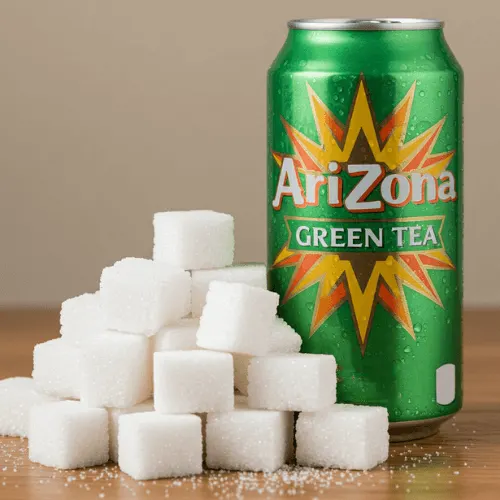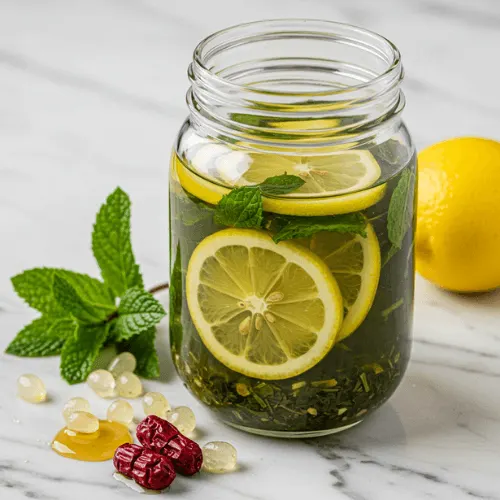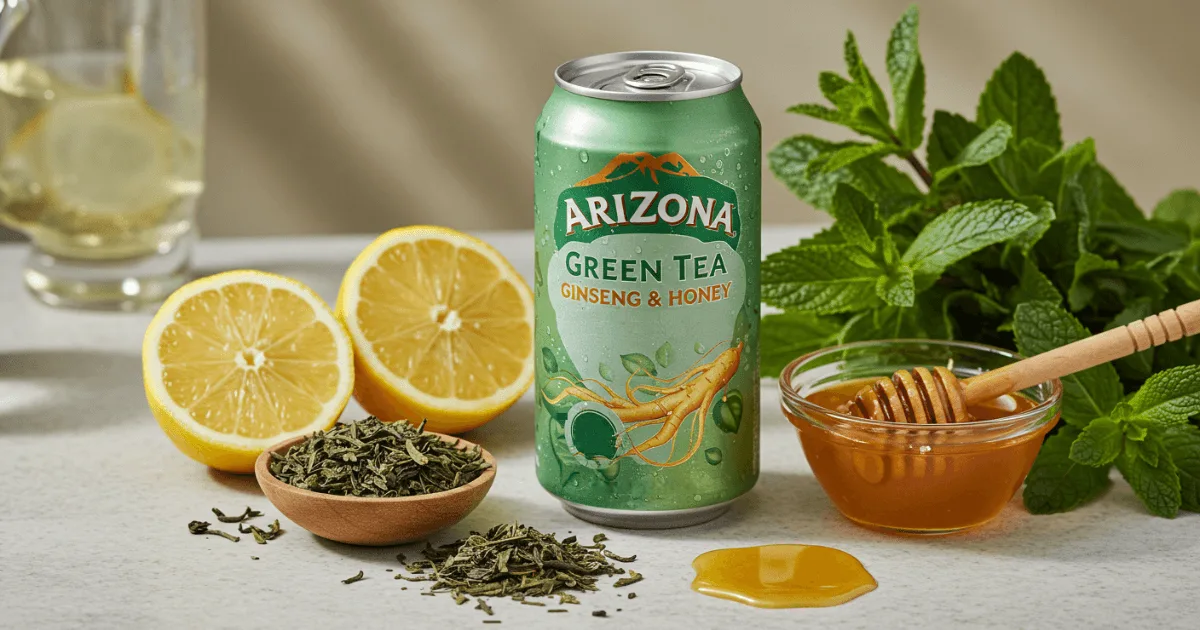You grab a cold can of Arizona Green Tea—maybe it’s for a refreshing kick on a summer day, or a nostalgic throwback to after-school chillouts. That iconic pastel can with cherry blossoms is instantly recognizable. But what if the sweet taste you love isn’t telling you the full story?
Let’s talk about Arizona Green Tea. You grab it thinking, “Hey, green tea and honey—that’s got to be good for me, right?” The label makes it sound like sunshine in a can. But here’s the thing: there’s some sneaky stuff going on with the ingredients. And since you’re probably drinking this all the time, you should know what’s really in it—no scare tactics, just the facts. Let’s break down what Arizona isn’t advertising loudly on that pretty label.
Table of Contents
What Makes Arizona Green Tea So Popular?
It’s everywhere—and it’s affordable. That tall 23-ounce can of Arizona Green Tea has become more than just a beverage; it’s a cultural icon. But why?
- Affordable Pricing: Most stores sell it for just $0.99.
- Aesthetic Branding: The cherry blossom design and cool branding create instant recognition.
- Sweet Taste: The flavor is sugary and satisfying, especially if you’re not a fan of bitter teas.
- Viral Memes & Internet Culture: The internet can’t stop talking about it.
Arizona Tea has built an empire on branding, accessibility, and taste. But what’s under the label?
What’s Really in Your Arizona Green Tea?
You see “green tea with ginseng and honey” on the label and think, “Sounds wholesome enough!” Yet, if you look at the other side of the can, the ingredients paint a different picture.. Let’s break it down—no jargon, just straight talk. The Not-So-Simple Ingredient List:
Brewed Green Tea
- The good stuff: Antioxidants, sure.
- The catch: It’s sharing the spotlight with…
High Fructose Corn Syrup (HFCS)
- Why it’s here: Cheap sweetness.
- The downside: Linked to blood sugar spikes and weight gain—basically, the opposite of “healthy tea.”
Honey
- The vibe: “Natural!”
- Reality: A tiny amount, dwarfed by HFCS. More for marketing than flavor.
Natural Flavors
- Sounds harmless, right?
- Truth: Could be anything from fruit extracts to lab-made compounds. No one has to tell us.
Citric Acid & Ascorbic Acid (Vitamin C)
- Pros: Keeps it fresh, adds a nutrient.
- Cons: Citric acid can bother sensitive stomachs.
The front of the can shouts “GREEN TEA! HONEY!”—but the first ingredient after water? High fructose corn syrup. That’s not a health drink; it’s liquid candy with a sprinkle of tea.

The Truth About Arizona Green Tea: 5 Shady Secrets
1. The “Natural” Label is a Decoy
That can with a vintage appearance featuring ‘green tea and honey’ prominently displayed? Total misdirection. The FDA doesn’t even regulate “natural flavors” strictly—it could be anything from actual herbs to lab-created chemicals that mimic them.And here’s the kicker: High fructose corn syrup (HFCS) is usually the second ingredient, meaning there’s more of it than the actual tea benefits you’re after.
Pro Tip: If the first three ingredients include HFCS, it’s soda in a tea costume.
2. The Caffeine is Like a Ninja—Silent But Present
Most people assume it’s caffeine-free because it’s not coffee, but nope—each 8-oz serving has about 15mg of caffeine. That’s less than brewed green tea (25–35mg), but if you’re sipping the whole 23-oz can, you’re still getting a decent buzz.
For sensitive folks: If caffeine gives you the jitters or messes with your sleep, don’t chug this after 3 PM.
3. The Sugar Content is Criminal (Seriously, 51g?!)
Let’s break this down:
- One 23-oz can = 51g sugar (that’s 13 teaspoons).
- According to the American Heart Association, women should consume no more than 25g of added sugar daily, while men should limit themselves to 36g—this single drink exceeds both recommendations.
And the “honey” they advertise? It’s like a guest appearance in a movie—barely noticeable next to the HFCS star.
Fun comparison: A 12-oz Coke has 39g sugar—Arizona’s bigger can still beats it.
4. The “Healthy” Ingredients Are Mostly for Show
Sure, green tea and ginseng sound great, but:
- Pasteurization kills most antioxidants (the main reason you’d drink green tea in the first place).
- The vitamin C (ascorbic acid) is added as a preservative, not for nutrition.
- Ginseng is in trace amounts—you’d need to drink 10 cans to get the dose in a real supplement.
Better alternative: Brew your unsweetened green tea and add real honey.
5. The Ginseng & Honey Are Just Cameos
Companies list ingredients from highest to lowest quantity. So when “ginseng extract” and “honey” are near the bottom, that means there’s way more sugar and water than actual beneficial ingredients.
Marketing trick: They slap those words on the label because they sound healthy, not because they’re meaningful.
Is Arizona Green Tea Good For You?
Okay, let’s settle this once and for all. That giant 99-cent can seems like a healthy choice—green tea! Honey! Ginseng!—but is it doing your body any favors?
The Good Stuff (Yes, There’s Some)
- Real green tea – It’s in there! Just… not as much as you’d think.
- Vitamin C boost – Thanks to added ascorbic acid (mostly to preserve it, but hey).
- Cheap & easy – No arguing with that price tag and convenience.
The Not-So-Good Stuff (Brace Yourself)
- Sugar overload – We’re talking 51g in one can—that’s more than two days’ worth of added sugar for most people. Yikes.
- Processing kills benefits – Pasteurization zaps most of green tea’s antioxidants, so you’re missing the best part.
- Label trickery – “Honey” and “ginseng” sound wholesome, but they’re just cameo appearances in a sea of HFCS.
Make Your Own Arizona-Style Green Tea (Without the Sugar Crash!)
Let’s be real—that big Arizona can taste great, but the sugar rush? Not so much. Here’s how to whip up a healthier homemade version that gives you the benefits of green tea (without the junk).
What You’ll Need:
- 1 cup brewed green tea (chilled)
- 1 tsp of organic honey, or add more if desired
- 3–5 drops of ginseng extract (find it at health stores)
- 1 tbsp fresh lemon juice (for that tangy kick)
- 4–5 mint leaves (trust me, it truly makes a difference)
- Ice cubes (as many as you want)
How to Make It:
- Brew and cool your green tea (steep for 3 mins max to avoid bitterness).
- Mix in honey and lemon juice—stir well so it’s not just sitting at the bottom.
- Add ginseng drops and mint leaves (crush the mint a little to release flavor).
- Pour over ice and enjoy!


Arizona Green Tea FAQs
Does Arizona Green Tea have caffeine?
Yep! It’s got about 15mg per 8oz—less than your average cup of brewed green tea (~30mg), but enough to notice if you’re sensitive. (Source: Caffeine Informer)
Is it healthy?
Short answer: Not really.
- Pros: Has real green tea (antioxidants!) and vitamin C.
- Downsides: The 51g of sugar per can offsets any advantages. (American Heart Association sugar guidelines)
Pro tip: If you’re after health perks, brew your own—here’s how to make perfect green tea.
Is it good for you, though?
Depends:
- For flavor? Sure, it’s tasty.
- For health? Nah. That much sugar = energy crashes.
- Better option: Try Honest Tea’s lightly sweetened version (just 11g sugar).
Is there alcohol in it?
Nope! Nope! Arizona drinks contain no alcohol, ensuring they’re safe for kids (although they might get a sugar rush).
What’s the deal with green tea benefits?
Real, unprocessed green tea can:
- Boost metabolism (NIH study)
- Sharpen focus (Healthline breakdown)
But Arizona’s pasteurization kills most of those perks.
Where’s it made? Arizona?
Fun fact: New York! The name’s just vibes. (Company history)
Who competes with Arizona?
Big names in iced tea:
- Snapple (more flavors, similar sugar)
- Pure Leaf (less processed, but pricier)
- Honest Tea (organic, lower sugar)
Compare them here: Iced Tea Showdown
The Hard Truth About Your Arizona Green Tea Habit
Look, I get it— that giant 99-cent can is tempting. It’s sweet, it’s refreshing, and that green tea label makes you feel kind of virtuous, right? But let’s cut through the marketing BS for a second.
Here’s the deal:
- Drinking this daily? You might as well be sipping soda with an identity crisis.
- That “healthy” green tea goodness? Mostly canceled out by the 13 teaspoons of sugar per can.
- The antioxidants you’re after? Pasteurization nuked most of them.
But I’m not here to judge. If you love the taste, and drink it occasionally? Cool. No shame in that game. But if you’re reaching for this every day thinking it’s doing your body favors… well, let’s just say Arizona’s marketing team deserves a raise.
Your Move:
- For the flavor: Try our homemade version (way less sugar, same refreshing taste)
- For actual benefits: Brew real green tea—it’s cheaper and good for you
- For convenience, check out lower-sugar options like Honest Tea
Life’s too short to drink stuff that’s working against you. You’ve got the facts now—what you do with them is up to you.
Pass it on: Tag that friend who’s always got an Arizona in hand. They might not thank you immediately… but their pancreas will.

